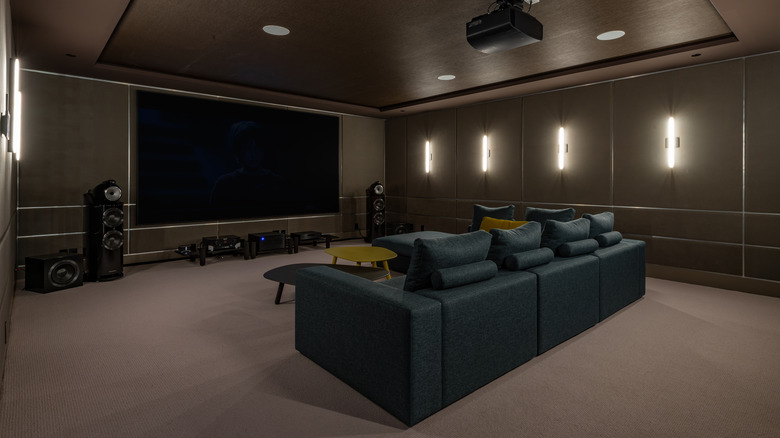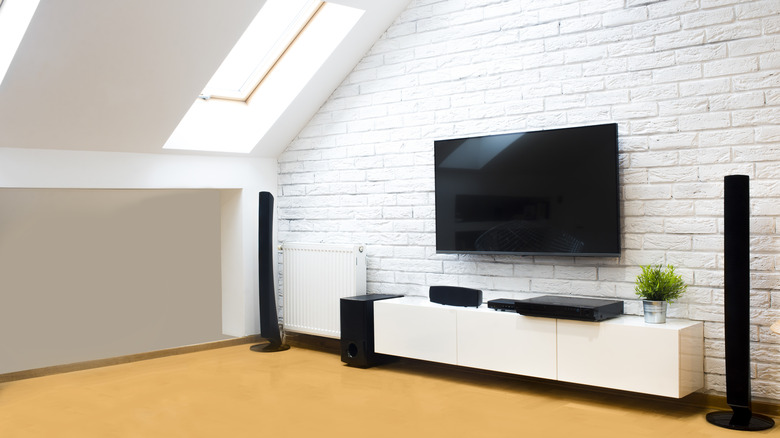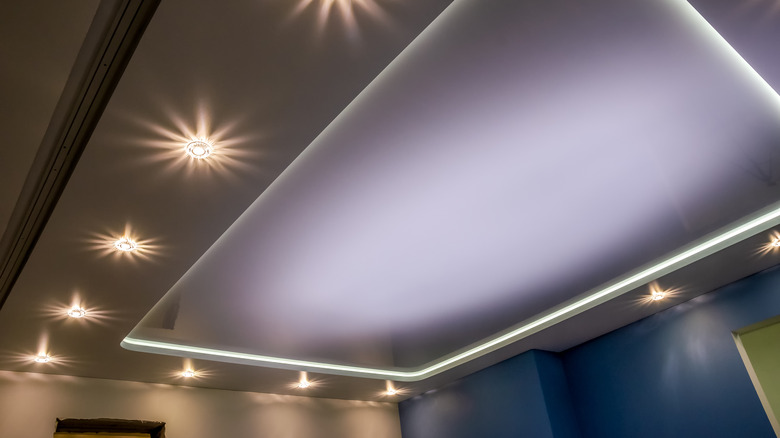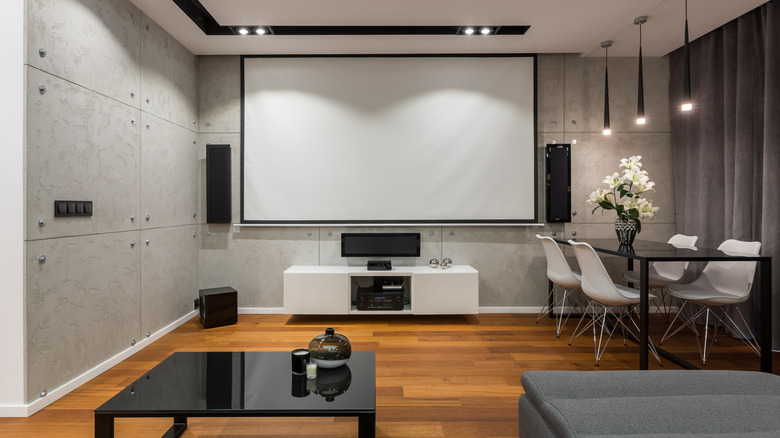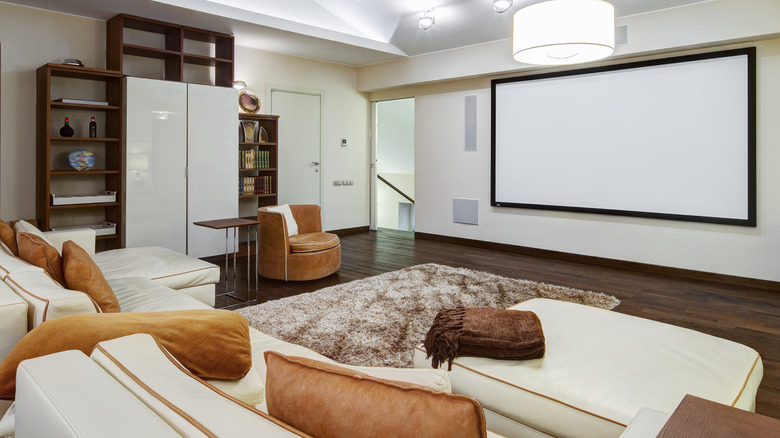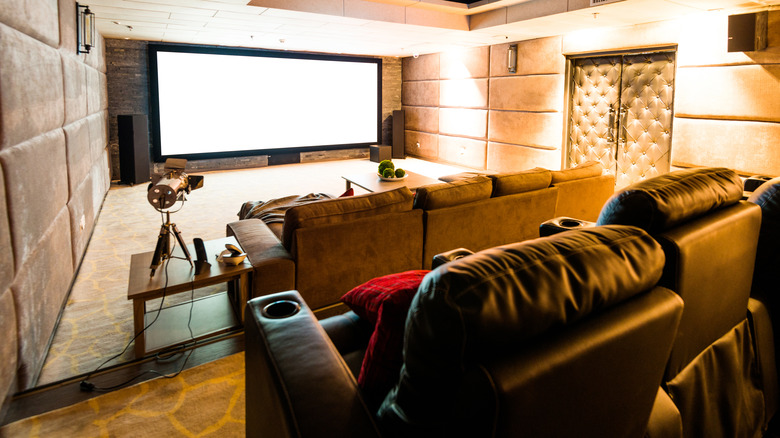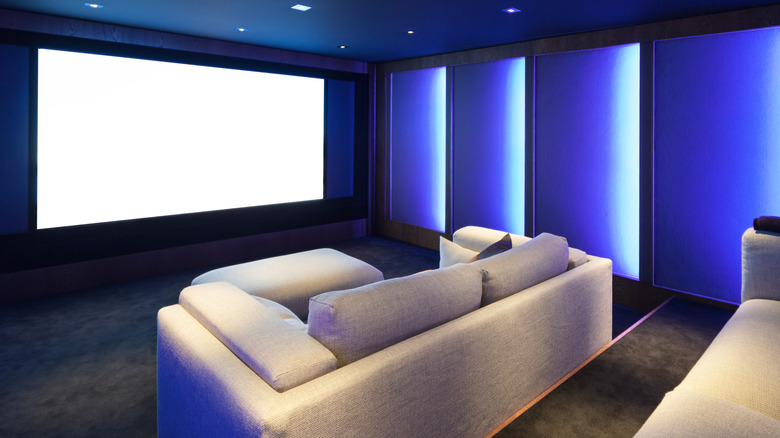15 Genius Tips For Designing The Perfect Theater Room
Everyone has different priorities in their dream home, with some preferring a massive kitchen for whipping up holiday meals and others valuing an abundance of green space to create an outdoor oasis complete with a vegetable garden and greenhouse. However, for movie buffs or simply those who love to binge watch their favorite shows, one fantastic addition to a home is a theater room. Sure, you can watch movies and television shows on any type of screen, but there's just something special about having the full experience, per HGTV.
However, beyond buying a large screen that can display whatever you're watching, it can be a bit intimidating to think of what exactly you need in the room. How big should the screen be? What type of seating do you need? Is added audio essential? And, when it comes to extras like snack bars and refrigerators, what should you splurge on and what should you ignore? Whatever your genre of choice, there are multiple elements to consider when designing the perfect movie viewing space — here's what you need to know to ensure you craft the ideal home theater room.
1. Figure out a dedicated space
When it comes to finding the ideal space for your home theater, there are a few key considerations, as noted by Architecture Ideas. While you can invest in materials and renovations that can help block out sound and light, it's easier to control the expense by finding a space that is removed from the noisiest areas in your home, and that doesn't feature an abundance of windows that allow in natural light.
You also need to consider size — you want a space with enough room that you're seated at a comfortable distance from the screen. Additionally, you may need a specific distance based on the type of screen or device you're using. For example, some projectors need up to 14 feet in order to project an image properly (via The Spruce).
2. Control the ambient lighting
Too much ambient light, or light coming from the wrong places, can wreak havoc on your viewing experience and impact the quality of the picture you're seeing. Controlling the lighting in a theater space is important, and is one of the first things you should consider when planning out your space, says Audio Advice.
If you're determined to set up your theater room in a space with endless windows, you'll need to find solutions that can darken all those light-emitting areas. If you've selected a room that doesn't have much ambient lighting, you may simply need to invest in some curtains, screens, or blinds in order to craft the ideal viewing experience. As an added bonus, many of these light-blocking solutions are relatively easy to install and can be found in a variety of styles that will match your home aesthetic.
3. Add in lighting
Though eliminating ambient light is a key consideration when planning out your home theater, you do want to strategically incorporate light in certain ways for the perfect space, according to Audio Advice. Flexibility is key — if possible, you want options that can be dimmed according to your preference in order to maintain the picture quality on your screen.
Depending on the layout of your home theater, you may also want to add some lighting along the perimeter of the room or along the ceiling, to add some ambient lighting. Or, perhaps you have a certain area that you want to illuminate with some accent lights. Just make sure that most of your added lighting is behind where you would sit to view the screen to avoid it impacting the screen's display.
4. Splash on some dark paint
Unless you've made the decision to paint them a certain color, chances are the ceilings in your home are a standard white. According to The Spruce, white paint is commonly used on ceilings because it reflects light, which can help make a space seem more open and airy.
However, that reflective quality is exactly what you don't want in a theater space; so, you may want to get a can of dark paint when you're creating your ideal set-up. Having a dark hue on the walls — like a deep charcoal or dark eggplant purple — as well as on the ceiling can help to control the lighting in the space, which is of utmost importance in a home theater.
5. Block out external noise
Next to light, noise is one of the most important things to consider when planning out a home theater space. Hopefully you're starting with a solid base, having picked a room that isn't in the most high-traffic area of your home. If price isn't an issue and you're building your home theater from the ground up, you may consider installing zero-sound drywall to soundproof the room, as HGTV suggests.
However, if you're just looking to improve the acoustics in your home theater without breaking the bank, consider incorporating options like drapes or sound panels that can effectively dampen the sound. If you don't want to make any changes to the walls, another option could be to swap out the door; use a solid core door rather than a hollow interior door to help battle sound waves. For an area where your eye isn't drawn as easily, such as the ceiling, you can install things like acoustic tiles.
6. Choose your screen
Today's technology means there are a host of options to consider, from the size of the screen to the type of screen. Consider the space itself first when deciding on size — you want about three feet of space below the screen for an optimal viewing experience, and if you go for a large size like 120 inches, you want to make sure your seating is far enough back that you can take in the full screen at once, per Audio One.
Then, decide whether you want a traditional flat-screen television or a projector with either a fixed frame or pull-down screen. Either way, make sure to properly survey the options and pick the one you like best; as it displays the graphics you're enjoying, the screen is one of the most important parts of your home theater.
7. Hide any wiring
The easiest way to reduce the amount of wires and cables is obviously to select items that are wireless, according to SV Sound — however, this isn't always an option. One strategy is to use existing elements in the room to hide the unsightly wires and cables, such as tucking some behind posters, routing flat cables underneath area rugs, or even bringing them along the crown molding or baseboards in the space.
For wires and cables that can't effectively be hidden, even just using zip-ties or clips to secure them to one area, or sticking a bundle of them into a cord concealer, can do wonders for the overall appearance of your theater room. For those who are really serious about eliminating wires and cables in their home theater, hiring a professional to hide them in the ceiling and walls can also be an option, although obviously a more costly one (via Yamaha Music USA).
8. Set up your audio-visual system
Once you've eliminated any ambient noise in your theater room as effectively as possible, the next step is to find the sound configuration you want for an optimal viewing experience. One of the primary ways you get so immersed in a movie when watching in a theater is because the sound seems to echo all around you, enveloping you in the experience.
According to DIY Network, most home theater rooms will feature an AV receiver as well as a subwoofer and about five or so speakers. The placement of your speakers will depend on the space you're working with, but often you'll want a center channel loudspeaker as well as one to the left and right front, placed equal distances from the television, and two rear surround sound speakers. That's what will give you the full immersive experience.
9. Decide on a control system
Some people may prefer a regular universal remote, and you can certainly set one up in a way that you can control the various aspects of your home theater. However, it's become increasingly common to simply use your cell phone as your control system — and it's a very convenient solution for many (via Tech Hive).
As LifeWire details, there are many different remote home theater control apps, available on both Android and iOS. Some require a bit more set-up than others, and some may be a bit more intuitive than others, but ultimately it's a matter of personal preference; you may want to explore a bit and see which app you think is the right one for you. Then, everyone has the ability to control their viewing experience right from their own phones.
10. Decide on seating options
Seating is another area where the sky's the limit, and you can really get creative according to what your overall vision for your home theater is, as noted by HGTV. Some individuals may prefer a solo viewing experience with separate armchairs for everyone. Others may want to recline, and place a high priority on seating options with that possibility. Or, maybe your ideal viewing experience means having your snacks close at hand, so you want a chair with built-in cup holders or a flat arm that something can be balanced on.
On the opposite end of the spectrum, perhaps you love movie nights and would prefer a couch or loveseat that can seat multiple people. Whatever your personal preference, make sure your seating options reflect it. Even things like the material might be worth considering — while softer fabrics can be cozy, you may want to go with leather for durability, if people may be spilling their popcorn and sodas.
11. Design your seating layout
Layout is key in your home theater — you want to ensure that everyone has a good view of the screen. Some prefer to incorporate a platform in order to avoid any blocked views. Even a modest platform of just a few inches can help ensure that those sitting in the back row of seats don't have their line of sight interrupted by those seated in front of them, according to The Spruce.
Your screen size will also play a role in your layout, as you want to ensure viewers are seated far enough back that they can take in the full screen. If you're having multiple rows of seats for a true mini-theater experience, you want to ensure there's enough space in between rows — about 20 inches is typically good, according to Theater Seat Store — so that people can navigate.
12. Add some cinematic flair
Design plays a major role in tying things together, and you have a ton of freedom and flexibility when it comes to creating your theater space, says Sebring Design Build. Perhaps you prefer a modern design aesthetic, and want a theater with sleek lines and a simple color palette. Or, maybe you're utterly charmed by the theaters you see in classic movies, and you want to add retro touches. Perhaps it's the time to invest in a few large posters of your favorite movies.
While there are certain necessary elements that go into a theater space, such as the audiovisual equipment, there's a lot of room for your own personal touch. Functionality is key, but remember to consider form as well, selecting items that fit your desired overall aesthetic to create a particular mood.
13. Control any reflective surfaces
In a home theater, reflective surfaces should be eliminated as much as possible because they can reflect light back and compromise the viewing experience, per The Spruce. This means you'll want to consider the reflective qualities of just about every element in your space, from the light fixtures and hardware such as doorknobs to the finish on your paint. For example, opting for matte or flat paints is preferable to a high-gloss paint that will reflect light.
Carefully consider all pieces in the room, especially anything that's located between the screen and where you're sitting. The simple step of painting something a matte black hue if it needs to be in your eyeline while watching something on the screen can work wonders when it comes to enhancing your viewing experience.
14. Add in your necessary extras
One of the benefits of creating your own theater room is that you can add exactly what you want in your movie or television-watching space. For example, if you can't sit through a movie without a freshly popped bowl of popcorn, you may want to add a microwave or even a popcorn machine to have your favorite buttery snack on hand, suggests HGTV. In order to ensure everyone has their drink of choice, you might consider incorporating a wine fridge or mini fridge to store a few bottles of crisp Sauvignon Blanc or your preferred non-alcoholic beverages.
Finally, if you're a fan of a particular franchise or even certain films, consider adding a few decorative touches that pay homage to that, whether it be in the form of some themed pillows, movie posters, etc.
15. Invest in streaming services or DVDs
There are a ton of options for streaming services for both television and movies in your home theater, including Netflix, Amazon Prime, Disney+, and Hulu, just to name a few. While you certainly can invest in DVDs if that's your preferred method of watching movies and television series, you may also want to consider signing up for a few streaming services so your theater room has an abundance of content at the ready, able to cater to whatever viewing mood you're in.
You may also want to look into what's available digitally for the particular genres or types of content you enjoy, as noted by PC Mag. Options such as Shudder exist for streaming horror flicks, while fans of arthouse movies may enjoy a service like Ovid.tv.
